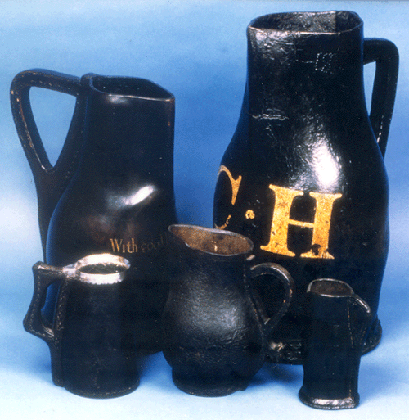… there’s an account over on the National Leather Collection blog.
Home » Period/Culture » Late Medieval
Category Archives: Late Medieval
Too good to not share…
The Museum of London leather jerkin in close up photographs.
Thanks to the Archaeological Leather Group for pointing it out.
Another brilliant idea
I had a great idea, but not one so great that my foot fell off. Why not make a copy of the bracer in the British Museum?, I thought. It will be easy, I thought. I have the report with a nice clear drawing.
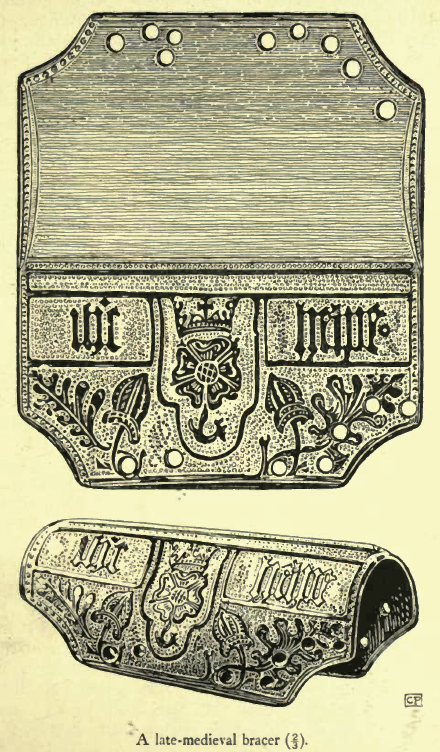
Dalton, Antiquities Journal, Volume 2, 1922 p209
It looks fine, right up to the point where you compare it with the photograph of the real thing…
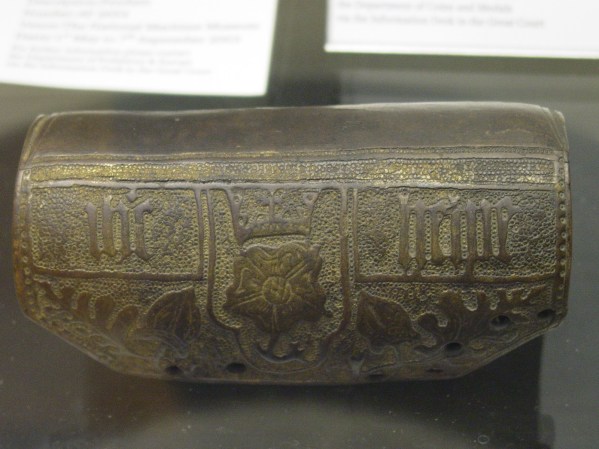
Bracer in the british Museum. My photo. That is an awful lot of gold.
When you try to use the published drawing, you find out there’s all these little fiddles like changing the size of the spots to make it work. The height of the decorated panel is okay but the two narrow ones above it are compressed. The lettering is all over the place as well and the sides of each panel don’t line up with each other in the same way they do on the original. Oh well, I’ll have to redraw it for the next one. The photo also shows how the gilding runs.
The process is simple enough. Transfer your design to the leather – because this one is to be gilt and painted, I just used plain old office carbon paper.
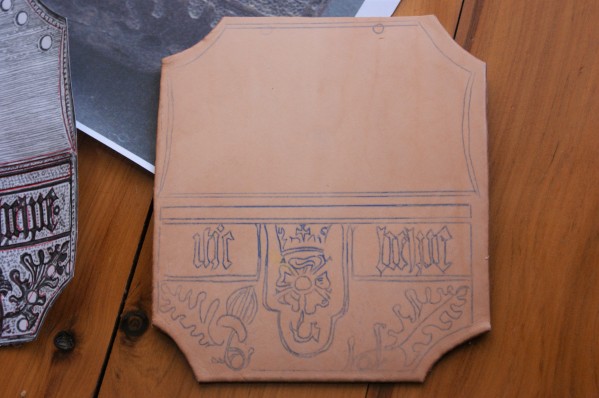
Straight off one of the problems becomes apparent. The pockles on the right have considerably more room than those on the left. I cut the outlines with a small straight blade as we’re predating swivel knives by several hundred years.
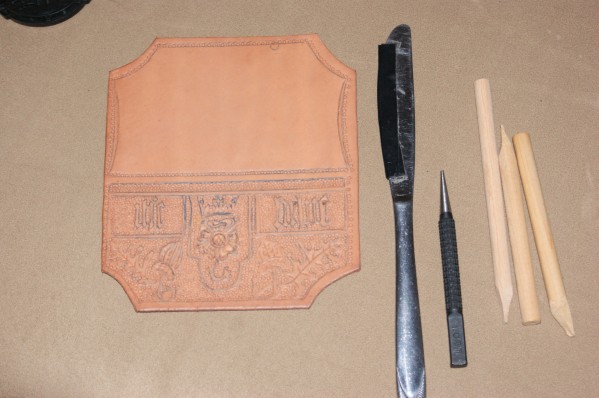
Empockelate appropriately with a 1.6mm nail punch, using kitchen utensils and home made punches as appropriate. Punch the holes for the strap, realising that they are too close to the edges and are the reason all the other holes were put in later for thong. Also realise that one hole in the drawing is too far to the right when compared to the other three. I tried swearing at this point, but it didn’t move the hole, so you can skip that if you like.
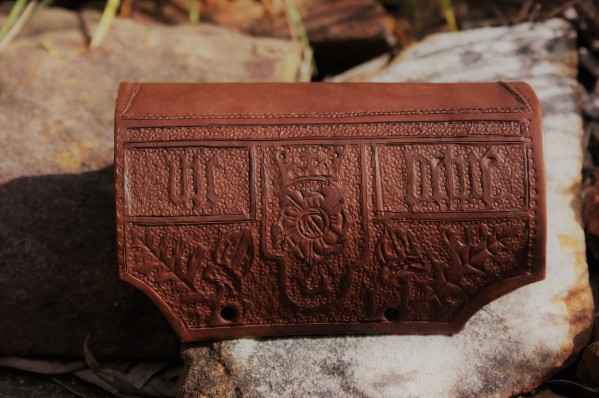
DieDye.
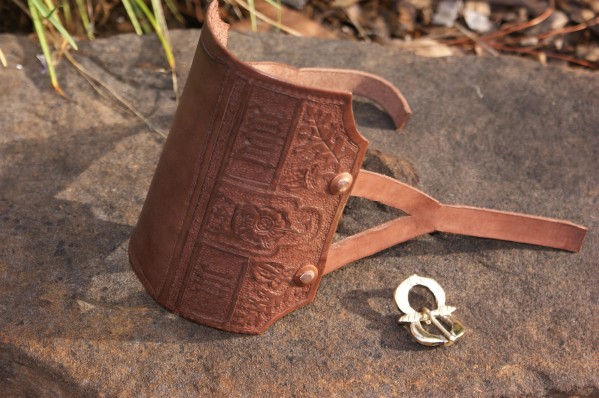
Enstrap and buckle. I either have to get faster at buckle making or give it up and buy them, I spend far too much time making the wretched things. I’ve gone with a copper alloy double oval loop buckle with moulded pin rests, making it date to between 1550 and 1650. [Whitehead, R., Buckles 1250-1800, Greenlight Publishing, Chelmsford 1996]
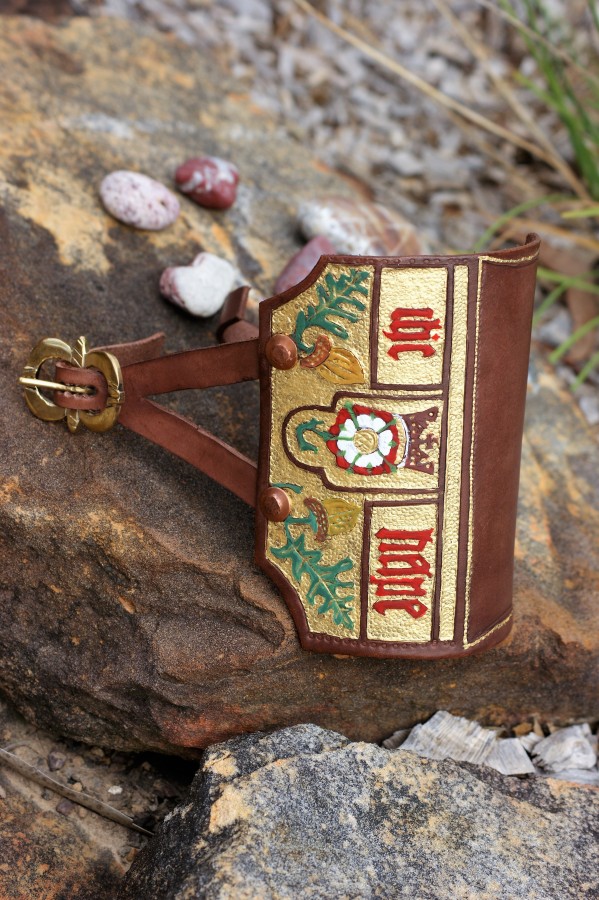
Painted bracer, it’s still a work in progress, I’ve since changed the colour of the crown.
Paint. The BM says some trace of pigment remains, having contacted them, it’s just a possible hint of red on the letters but they couldn’t tell me what the pigment was and if it was colour or bole (primer for the gilding). I’m going with colour, mainly from an ostentation point of view. Minium (red lead) substitute, rather than iron red in this case because it will be the same as on the rose. I also think the gilding is shell gold rather than leaf due to the way it sits down into the background rings and the narrow strips along the top and back would just be way too fiddly. There’s no evidence of the use of size under the gold in this case, either.
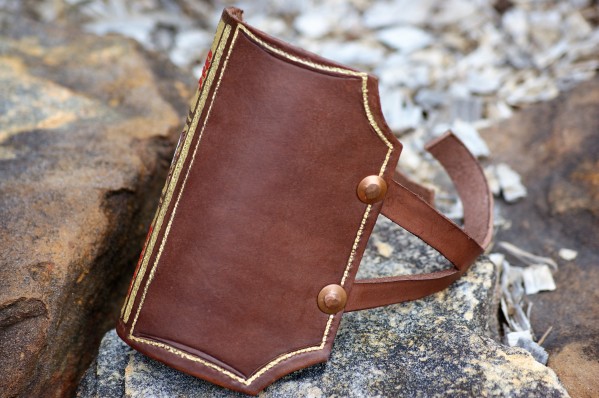
The painting on the other side is restricted to just lining.
I’m doing a Tudor rose, contemporary with the text, rather than a Yorkist white rose to match the tradition. It’s slipped and crowned (which may make it as late as Henry VIII or even Elizabeth) which didn’t happen with York white roses and I’m doing brown and ochre oak leaves and acorns, just because.
Yeah, it’s acrylic paint. Yes, I know I’ll have to apologise to Jesus, but I’ve been lead to understand that he’s fairly forgiving.
So I think I’ve finished it, it’s gone well as a fair copy of the reported illustration but I’m largely unsatisfied with it. I’ll have to have another go later.
While we’re on the subject, I need to vent a bit. The report begins on p208 of the Antiquities Journal with the sentence, “THE archer’s bracer illustrated in the fig. on p. 209 is of cuir bouilli, …” The BM repeat the assertion in their online catalogue.
I’m not sure what the fascination of antiquaries/archaeologists of this period is with cuir bouilli, they see it everywhere. Cuir bouilli, as the name implies, is a heat curing process that by its nature precludes tooling of the finished article. If you’re after more information on the subject, have a look at the late Marc Carlson’s Hardened Leather (Wayback Machine Internet Archive link) which also has some experiments on different methods.
Finished Archer’s Bracers
This post is a follow up to Archer’s Bracers and Wooden Stamps (again) of the year before last. It’s mostly me showing off, with some self-justification to explain the decisions I made about dye colours and buckles. I started writing this post in September 2014, so forgive me if things seem a little outdated.
I’m quoting from Gervase Markham’s The Art of Archerie (1634) here, mainly for my own convenience because I can cut and paste from the ebook. Markham was a publisher and like his peers, made his money from the sheer number of different titles he sold rather than the more modern approach of having fewer stronger selling titles. Accuracy, readability, veracity and respecting ownership of intellectual property were not his strong points. In this case, he’s written a new dedicatory epistle to the king, a new first chapter (A general encomion or praise of shooting both in peace and war) and then basically plagiarized the second book of Ascham’s Toxophilus when he thought everyone had stopped reading. He has modernised Ascham’s language somewhat and added the occasional paragraph of his own.
…the bracer serves for two purposes, the one to save the arm from the stripe of the string, and his doublet from wearing; and the other, that the string gliding sharply and quickly of the bracer may make the sharper shot, for if the string should light upon the bare sleeve, the strength of the shot would stop and die there…
This next bit seems to be Markham’s own work and reflects mid-17th century practice rather than 16th c, Ascham is silent on the appropriate types of leather.
The bracers are made for the most part of Spanish leather, the smooth side outward, and they be the best, sometimes of Spanish leather and the flesh side outward, and they are both good and tolerable, and others are made of hard, stiff but smooth bend leather, and they be the worst and most dangerous, and thus much is spoken of the bracer.
When looking at the Mary Rose bracers, all are skin side outwards and only a couple are candidates for being of Spanish leather. I’ve used harness butt for all mine, it’s thick, flexible and takes stamping well. Most of the Mary Rose bracers are rectangular or octagonal, with a couple having curves on the long sides. I made a couple of each design, patterns were just the drawings from the MR book blown up to life size on a photocopier. Cut out the leather, case it and decorate with the stamps you made two years ago. Attack with the back of the butter knife if your design needs it. You may have done that two years ago as well…
Buckle and strap
Cut the straps to the correct width to fit the actual or hypothetical buckle and punch the holes for the rivets and mounting the buckle. I used a thin 1.5mm carving leather for the straps on the commercial buckles and a 3mm on the ones I’d made. “Y” shaped straps can be made by splitting a straight strap for part of its length, dampening the branching area and then stretching and squeezing to shape.
Dye the bits as required with your choice of leather dye. I used red on a couple to represent Spanish leather (the red colour came from a step in the tanning process), the majority are black or brown.
Mild steel buckles
My bracer has a forged buckle, but to show what you can do at home, I made these from a piece of 1.6mm sheet mild steel I’d picked up from the local hardware. The shapes are entirely hypothetical because none of the Mary Rose bracer buckles have survived. The holes have been drilled and then opened up with files. On some of the square ones, I stitch drilled and then cut the webs with a cold chisel. Decoration is with sharp or blunt cold chisels and a centre punch. The buckle tongues are horseshoe nails with the heads cut off and then bent to an appropriate shape. Don’t forget to clean and debur the front and back.
The finish is a simple heat blue, a stable oxide of iron. I use a similar process to this, either using a propane torch or gas ring depending on what the gas bottle is connected to, but finish with a spray oil rather than a dip. Just do it outside and don’t breathe the fumes. You can blue in your oven if it can heat to 290°C/550°F.
Assemble all the bits using copper harness rivets (the impressions in the leather match the Mary Rose examples) and wax or seal to taste.
International Museum of Leather Craft
IMOLC have recently discovered that they don’t own the collection of jacks, bombards and bottels that they’ve had on display in the old museum for the past 70 years. They have until the start of March to crowdfund £33000 otherwise the collection will be broken up and sold off. For details, see IMOLC’s blog post.
